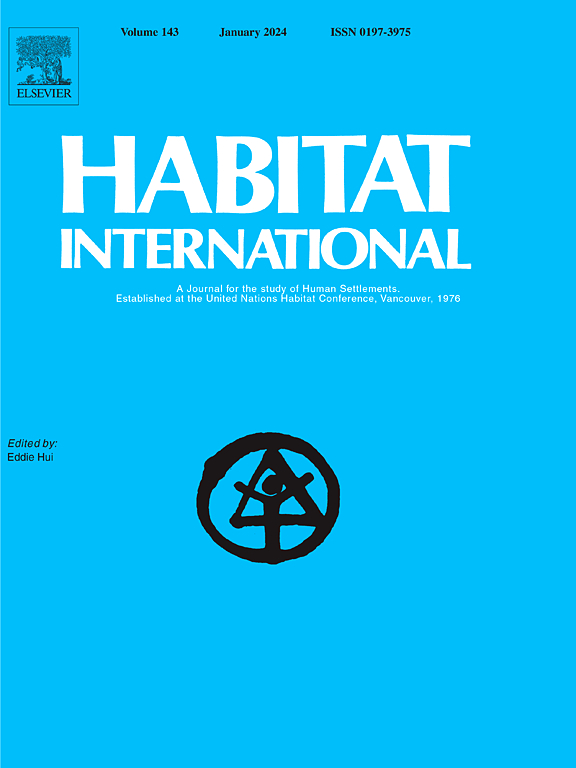迈向高质量国土空间:空间质量理论与社会空间不平等测度
IF 7
1区 经济学
Q1 DEVELOPMENT STUDIES
引用次数: 0
摘要
在美好生活和可持续发展的双重诉求下,塑造高质量国土空间既是地方政府的政策目标,也是社会大众的追求。然而,对国土空间质量(TSQ)方法和理论的有限关注可能会误导决策,阻碍高质量的空间发展。本研究初步构建了TSQ的理论框架、概念模型和评价体系,为决策者量化TSQ的空间分布和社会空间不平等提供了一个实用的、可解释的决策支持工具。结果表明:高质量国土空间主要分布在高海拔山区和城市中心区,低质量国土空间主要分布在农业和城乡结合部。值得注意的是,只有20%的人口拥有83%的高质量领土空间机会。与老年人相比,未成年人和劳动年龄群体在获得匹配的优质空间方面面临更大的挑战,这表明社会分配不公平的问题。此外,31%的人口对匹配领土空间的需求仍未得到满足,表现出显著的空间异质性,特别是在城市中心、北部农业区和南部农村聚落,表明空间分布不公平的问题。因此,我们建议政策制定者从传统的以数量、结构和功能为导向的方法转向以质量、需求为导向的范式,以更有效地解决TSQ不平等问题。我们的研究结果有助于厘清现有国土空间与期望的高质量国土空间之间的差距,为以人为本的空间治理和规划提供见解,以支持更公平和可持续的国土发展。本文章由计算机程序翻译,如有差异,请以英文原文为准。
Towards high-quality territorial spaces: Theorizing space quality and measuring its social-spatial inequities
Under the dual demands for a better life and sustainable development, shaping high-quality territorial space is both a policy goal for local governments and a public pursuit. However, the limited focus on territorial space quality (TSQ) methods and theories may misguide decision-making and hinder high-quality space development. This study preliminarily establishes a theoretical framework, conceptual model, and assessment system for TSQ, offering policymakers a practical and interpretable decision-support tool for quantifying the spatial distribution and social-spatial inequities of TSQ. The results showed that high-quality territorial spaces were primarily located in high-altitude mountainous and urban central areas, whereas low-quality territorial spaces were mainly located in agricultural and urban-rural fringe areas. Notably, only 20 % of the population had 83 % of the opportunities for high-quality territorial spaces. Minors and working-age groups faced greater challenges in obtaining matched quality spaces than the elderly, demonstrating the problem of social distribution inequities. Besides, 31 % of the population's demands for matched territorial spaces remains unmet, showing significant spatial heterogeneity, particularly in central urban, northern agricultural regions, and southern rural settlements, demonstrating the problem of spatial distribution inequity. Therefore, we recommend that policymakers shift from traditional quantity-, structure-, and function-oriented approaches to a quality-demand-driven paradigm to address TSQ inequities more effectively. Our findings help to clarify the gap between existing territorial space and the desired high-quality territorial space, providing insights for human-centered spatial governance and planning to support more equitable and sustainable territorial development.
求助全文
通过发布文献求助,成功后即可免费获取论文全文。
去求助
来源期刊

Habitat International
Multiple-
CiteScore
10.50
自引率
10.30%
发文量
151
审稿时长
38 days
期刊介绍:
Habitat International is dedicated to the study of urban and rural human settlements: their planning, design, production and management. Its main focus is on urbanisation in its broadest sense in the developing world. However, increasingly the interrelationships and linkages between cities and towns in the developing and developed worlds are becoming apparent and solutions to the problems that result are urgently required. The economic, social, technological and political systems of the world are intertwined and changes in one region almost always affect other regions.
 求助内容:
求助内容: 应助结果提醒方式:
应助结果提醒方式:


